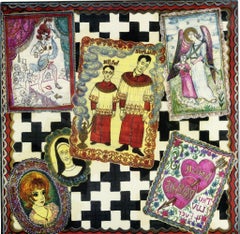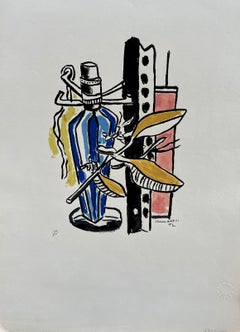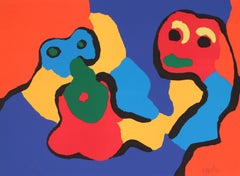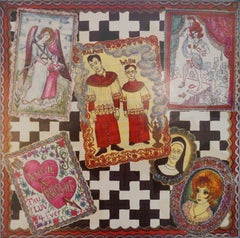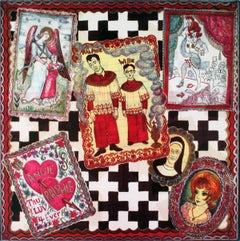Thomas Lanigan-Schmidt Art
to
1
1
1
Overall Height
to
Overall Width
to
1
1
1
1
1
1
1
1
6,886
3,210
2,514
1,217
1
Artist: Thomas Lanigan-Schmidt
Untitled, from from the Artsounds Collection
By Thomas Lanigan-Schmidt
Located in New York, NY
Thomas Lanigan-Schmidt
Untitled, from from the Artsounds Collection, 1986
Lithograph on paper
Signed and numbered from the edition of 200 in ink on the back; also bears artist's stam...
Category
1980s Outsider Art Thomas Lanigan-Schmidt Art
Materials
Lithograph
Related Items
Composition a la bouteille bleue
By (after) Fernand Léger
Located in Belgrade, MT
This print is part of my private collection. They were published in a numbered unsigned edition of 1000, and a signed edition of 200, printed by Serifraphie Fernand Leger, Paris and ...
Category
Mid-20th Century Cubist Thomas Lanigan-Schmidt Art
Materials
Lithograph
Some People Together
By Karel Appel
Located in New York, NY
Some People Together, 1974
Hand-signed and dated in pencil
Color lithograph and screenprint
Sheet 22 x 29 3/4 inches; 559 x 756 mm.
Edition 110
Category
1970s Modern Thomas Lanigan-Schmidt Art
Materials
Lithograph, Screen
1945 Mexican Modernist Silkscreen Serigraph Print Regional Folk Art Dress Mexico
Located in Surfside, FL
This listing is for the one Silkscreen serigraph piece listed here.
Mexico City, 1945. First edition. plate signed, limited edition of 1000, these serigraph plates depict various types of traditional and folk art indigenous clothing and costume styles from around Mexico. The illustrations depict the cultures of many different states in Mexico, including Oaxaca, Chiapas, Jalisco and Veracruz.
Carlos Mérida (December 2, 1891 – December 21, 1985) was a Guatemalan artist who was one of the first to fuse European modern painting to Latin American themes, especially those related to Guatemala and Mexico. He was part of the Mexican muralism movement in subject matter but less so in style, favoring a non-figurative and later geometric style rather than a figurative, narrative style. Mérida is best known for canvas and mural work, the latter including elements such as glass and ceramic mosaic on major constructions in the 1950s and 1960s. One of his major works, on the Benito Juarez housing complex, was completely destroyed with the 1985 Mexico City earthquake, but a monument to it exists at another complex in the south of the city.
Carlos Mérida was born Carlos Santiago Ortega in Guatemala City to Serapio Santiago Mérida and Guadalupe Ortega Barnoya. He later changed his name what is known by as he thought it was more sonorous. His brothers and children also took the Mérida name later on. He was of mixed Spanish/Maya-Quiché heritage which he promoted during his life.
As a young child, Mérida had both music and art lessons, and his first passion was music, which led to piano lessons. He studied at a trade school called the Instituto de Artes y Oficios, then the Instituto de Ciencias y Letras. Here he began to have a reputation for the avant garde.
Merída’s first trip to the United States was in 1917, where he met writer Juan José Tablada. Mérida made several trips to Europe over his lifetime to both study art and work as an artist and diplomat. His early trips in the 1920s and 1930s put him in touch with both avant garde movements in Europe as well as noted Latin American artists, especially those from Mexico. His last trip was in 1950s.
In 1963, he donated canvases, graphic pieces and mural sketches to the Universidad Nacional Autónoma de Mexico. Merida was one of a number of artists such as Diego Rivera and Gerardo Murillo who became committed to promoting the handcrafts and folk art of Mexico and Central America, with a particular interest in those of Guatemala, often featuring Mayan textiles or elements in their decoration in his artwork. He died in Mexico City at the age of 94 on December 21, 1985.
As there was little opportunity for artists in Guatemala, in 1910, Mérida traveled to Paris with a friend named Carlos Valenti on a German cargo ship. From then until 1914, he lived and worked in Paris and traveled much of Europe. This put him in touch with European avant garde artists such as Van Dagen, Amedeo Modigliani, Pablo Picasso and Piet Mondrian as well as Latin American artists studying in Europe such as Diego Rivera, Jorge Enciso, Ángel Zárraga and Dr. Atl. He exhibited his work in venues such as the Independent Salon and the Giroux Gallery in Paris.
Mérida has forty five exhibitions in the United States and eighteen in Mexico from 1928 to 1948. These included an exhibition with Rufino Tamayo at the Art Center of New York (1930), the John Becker and Valentine galleries in New York (1930), the Club de Escritores de México and the Galería Posada in Mexico City (1931), the Stendhal Gallery and the Stanley Rose...
Category
1940s Folk Art Thomas Lanigan-Schmidt Art
Materials
Screen
Serigraphie Fernand Leger
By Fernand Léger
Located in Belgrade, MT
This print is part of my private collection. They were published in a numbered unsigned edition of 1000, and a signed edition of 200, printed by Serifraphie Fernand Leger, Paris and ...
Category
Mid-20th Century Abstract Expressionist Thomas Lanigan-Schmidt Art
Materials
Lithograph
1945 Mexican Modernist Silkscreen Serigraph Print Regional Folk Art Dress Mexico
Located in Surfside, FL
This listing is for the one Silkscreen serigraph piece listed here.
Mexico City, 1945. First edition. plate signed, limited edition of 1000, these serigraph plates depict various types of traditional and folk art indigenous clothing and costume styles from around Mexico. The illustrations depict the cultures of many different states in Mexico, including Oaxaca, Chiapas, Jalisco and Veracruz.
Carlos Mérida (December 2, 1891 – December 21, 1985) was a Guatemalan artist who was one of the first to fuse European modern painting to Latin American themes, especially those related to Guatemala and Mexico. He was part of the Mexican muralism movement in subject matter but less so in style, favoring a non-figurative and later geometric style rather than a figurative, narrative style. Mérida is best known for canvas and mural work, the latter including elements such as glass and ceramic mosaic on major constructions in the 1950s and 1960s. One of his major works, on the Benito Juarez housing complex, was completely destroyed with the 1985 Mexico City earthquake, but a monument to it exists at another complex in the south of the city.
Carlos Mérida was born Carlos Santiago Ortega in Guatemala City to Serapio Santiago Mérida and Guadalupe Ortega Barnoya. He later changed his name what is known by as he thought it was more sonorous. His brothers and children also took the Mérida name later on. He was of mixed Spanish/Maya-Quiché heritage which he promoted during his life.
As a young child, Mérida had both music and art lessons, and his first passion was music, which led to piano lessons. He studied at a trade school called the Instituto de Artes y Oficios, then the Instituto de Ciencias y Letras. Here he began to have a reputation for the avant garde.
Merída’s first trip to the United States was in 1917, where he met writer Juan José Tablada. Mérida made several trips to Europe over his lifetime to both study art and work as an artist and diplomat. His early trips in the 1920s and 1930s put him in touch with both avant garde movements in Europe as well as noted Latin American artists, especially those from Mexico. His last trip was in 1950s.
In 1963, he donated canvases, graphic pieces and mural sketches to the Universidad Nacional Autónoma de Mexico. Merida was one of a number of artists such as Diego Rivera and Gerardo Murillo who became committed to promoting the handcrafts and folk art of Mexico and Central America, with a particular interest in those of Guatemala, often featuring Mayan textiles or elements in their decoration in his artwork. He died in Mexico City at the age of 94 on December 21, 1985.
As there was little opportunity for artists in Guatemala, in 1910, Mérida traveled to Paris with a friend named Carlos Valenti on a German cargo ship. From then until 1914, he lived and worked in Paris and traveled much of Europe. This put him in touch with European avant garde artists such as Van Dagen, Amedeo Modigliani, Pablo Picasso and Piet Mondrian as well as Latin American artists studying in Europe such as Diego Rivera, Jorge Enciso, Ángel Zárraga and Dr. Atl. He exhibited his work in venues such as the Independent Salon and the Giroux Gallery in Paris.
Mérida has forty five exhibitions in the United States and eighteen in Mexico from 1928 to 1948. These included an exhibition with Rufino Tamayo at the Art Center of New York (1930), the John Becker and Valentine galleries in New York (1930), the Club de Escritores de México and the Galería Posada in Mexico City (1931), the Stendhal Gallery and the Stanley Rose...
Category
1940s Folk Art Thomas Lanigan-Schmidt Art
Materials
Screen
See me running again - Lithograph -1978 - Handsigned - 172/175 - Modern abstract
By Karel Appel
Located in Sint-Truiden, BE
Karel Appel. Title: See me running again by Appel Series.
Technology: Lithograph.
Published by Atelier Dumas of New York, U.S.A.
Paper size format: 76 x 56 cm. Year: 1978.
Framed...
Category
1970s Abstract Thomas Lanigan-Schmidt Art
Materials
Lithograph
1945 Mexican Modernist Silkscreen Serigraph Print Regional Folk Art Dress Mexico
Located in Surfside, FL
This listing is for the one Silkscreen serigraph piece listed here.
Mexico City, 1945. First edition. plate signed, limited edition of 1000, these serigraph plates depict various types of traditional and folk art indigenous clothing and costume styles from around Mexico. The illustrations depict the cultures of many different states in Mexico, including Oaxaca, Chiapas, Jalisco and Veracruz.
Carlos Mérida (December 2, 1891 – December 21, 1985) was a Guatemalan artist who was one of the first to fuse European modern painting to Latin American themes, especially those related to Guatemala and Mexico. He was part of the Mexican muralism movement in subject matter but less so in style, favoring a non-figurative and later geometric style rather than a figurative, narrative style. Mérida is best known for canvas and mural work, the latter including elements such as glass and ceramic mosaic on major constructions in the 1950s and 1960s. One of his major works, on the Benito Juarez housing complex, was completely destroyed with the 1985 Mexico City earthquake, but a monument to it exists at another complex in the south of the city.
Carlos Mérida was born Carlos Santiago Ortega in Guatemala City to Serapio Santiago Mérida and Guadalupe Ortega Barnoya. He later changed his name what is known by as he thought it was more sonorous. His brothers and children also took the Mérida name later on. He was of mixed Spanish/Maya-Quiché heritage which he promoted during his life.
As a young child, Mérida had both music and art lessons, and his first passion was music, which led to piano lessons. He studied at a trade school called the Instituto de Artes y Oficios, then the Instituto de Ciencias y Letras. Here he began to have a reputation for the avant garde.
Merída’s first trip to the United States was in 1917, where he met writer Juan José Tablada. Mérida made several trips to Europe over his lifetime to both study art and work as an artist and diplomat. His early trips in the 1920s and 1930s put him in touch with both avant garde movements in Europe as well as noted Latin American artists, especially those from Mexico. His last trip was in 1950s.
In 1963, he donated canvases, graphic pieces and mural sketches to the Universidad Nacional Autónoma de Mexico. Merida was one of a number of artists such as Diego Rivera and Gerardo Murillo who became committed to promoting the handcrafts and folk art of Mexico and Central America, with a particular interest in those of Guatemala, often featuring Mayan textiles or elements in their decoration in his artwork. He died in Mexico City at the age of 94 on December 21, 1985.
As there was little opportunity for artists in Guatemala, in 1910, Mérida traveled to Paris with a friend named Carlos Valenti on a German cargo ship. From then until 1914, he lived and worked in Paris and traveled much of Europe. This put him in touch with European avant garde artists such as Van Dagen, Amedeo Modigliani, Pablo Picasso and Piet Mondrian as well as Latin American artists studying in Europe such as Diego Rivera, Jorge Enciso, Ángel Zárraga and Dr. Atl. He exhibited his work in venues such as the Independent Salon and the Giroux Gallery in Paris.
Mérida has forty five exhibitions in the United States and eighteen in Mexico from 1928 to 1948. These included an exhibition with Rufino Tamayo at the Art Center of New York (1930), the John Becker and Valentine galleries in New York (1930), the Club de Escritores de México and the Galería Posada in Mexico City (1931), the Stendhal Gallery and the Stanley Rose...
Category
1940s Folk Art Thomas Lanigan-Schmidt Art
Materials
Screen
1945 Mexican Modernist Silkscreen Serigraph Print Regional Dress Carlos Merida
Located in Surfside, FL
This listing is for the one Silkscreen serigraph piece listed here.
Mexico City, 1945. First edition. plate signed, limited edition of 1000, these serigraph plates depict various types of traditional and folk art indigenous clothing and costume styles from around Mexico. The illustrations depict the cultures of many different states in Mexico, including Oaxaca, Chiapas, Jalisco and Veracruz.
Carlos Mérida (December 2, 1891 – December 21, 1985) was a Guatemalan artist who was one of the first to fuse European modern painting to Latin American themes, especially those related to Guatemala and Mexico. He was part of the Mexican muralism movement in subject matter but less so in style, favoring a non-figurative and later geometric style rather than a figurative, narrative style. Mérida is best known for canvas and mural work, the latter including elements such as glass and ceramic mosaic on major constructions in the 1950s and 1960s. One of his major works, on the Benito Juarez housing complex, was completely destroyed with the 1985 Mexico City earthquake, but a monument to it exists at another complex in the south of the city.
Carlos Mérida was born Carlos Santiago Ortega in Guatemala City to Serapio Santiago Mérida and Guadalupe Ortega Barnoya. He later changed his name what is known by as he thought it was more sonorous. His brothers and children also took the Mérida name later on. He was of mixed Spanish/Maya-Quiché heritage which he promoted during his life.
As a young child, Mérida had both music and art lessons, and his first passion was music, which led to piano lessons. He studied at a trade school called the Instituto de Artes y Oficios, then the Instituto de Ciencias y Letras. Here he began to have a reputation for the avant garde.
Merída’s first trip to the United States was in 1917, where he met writer Juan José Tablada. Mérida made several trips to Europe over his lifetime to both study art and work as an artist and diplomat. His early trips in the 1920s and 1930s put him in touch with both avant garde movements in Europe as well as noted Latin American artists, especially those from Mexico. His last trip was in 1950s.
In 1963, he donated canvases, graphic pieces and mural sketches to the Universidad Nacional Autónoma de Mexico. Merida was one of a number of artists such as Diego Rivera and Gerardo Murillo who became committed to promoting the handcrafts and folk art of Mexico and Central America, with a particular interest in those of Guatemala, often featuring Mayan textiles or elements in their decoration in his artwork. He died in Mexico City at the age of 94 on December 21, 1985.
As there was little opportunity for artists in Guatemala, in 1910, Mérida traveled to Paris with a friend named Carlos Valenti on a German cargo ship. From then until 1914, he lived and worked in Paris and traveled much of Europe. This put him in touch with European avant garde artists such as Van Dagen, Amedeo Modigliani, Pablo Picasso and Piet Mondrian as well as Latin American artists studying in Europe such as Diego Rivera, Jorge Enciso, Ángel Zárraga and Dr. Atl. He exhibited his work in venues such as the Independent Salon and the Giroux Gallery in Paris.
Mérida has forty five exhibitions in the United States and eighteen in Mexico from 1928 to 1948. These included an exhibition with Rufino Tamayo at the Art Center of New York (1930), the John Becker and Valentine galleries in New York (1930), the Club de Escritores de México and the Galería Posada in Mexico City (1931), the Stendhal Gallery and the Stanley Rose...
Category
1940s Folk Art Thomas Lanigan-Schmidt Art
Materials
Screen
Some People Together
By Karel Appel
Located in New York, NY
Some People Together, 1974
Hand-signed and dated in pencil
Color lithograph and screenprint
Sheet 22 x 29 3/4 inches; 559 x 756 mm.
Edition 110
Category
1970s Modern Thomas Lanigan-Schmidt Art
Materials
Lithograph, Screen
Le Reve de Paris
By Marc Chagall
Located in New York, NY
Marc Chagall
Le Rêve de Paris (Paris Dream), 1969-70
Color lithograph on Arches wove paper
35 3/8 in x 25 1/4 in (90 cm x 64 cm)
40 1/8 in x 28 1/8 in (101.8 cm x 71.5 cm)
Numbered f...
Category
1960s Modern Thomas Lanigan-Schmidt Art
Materials
Lithograph
Henri Matisse Loan Exhibition vintage exhibition poster " Beverly Hills
By Henri Matisse
Located in Spokane, WA
Original vintage exhibition poster: HENRI MATISSE EXHIBITION. Linen baked in excellent condition, ready to frame. The background is a flat...
Category
1950s Post-Impressionist Thomas Lanigan-Schmidt Art
Materials
Lithograph
H 22 in W 17.5 in D 0.05 in
"Venus Noire", Rufino Tamayo, Figurative Abstraction, Etching, 30x22 in.
By Rufino Tamayo
Located in Dallas, TX
"Venus Noire" by Rufino Tamayo is a Figurative Abstraction lithograph limited edition measuring 30x22 in. The piece is framed beautifully with a white mat in a gold and black frame u...
Category
1960s Abstract Expressionist Thomas Lanigan-Schmidt Art
Materials
Lithograph
Previously Available Items
UNTITLED (from the ARTSOUNDS Collection)
By Thomas Lanigan-Schmidt
Located in New York, NY
THOMAS LANIGAN-SCHMIDT
Untitled (from the Artsounds Collection), 1986
color offset print, ed. 200
12 x 12 cm. 30.5 x 30.5 cm.
signed and numbered in pen by the artist on verso, al...
Category
1980s Contemporary Thomas Lanigan-Schmidt Art
Materials
Offset
Thomas Lanigan-Schmidt-From Art Sounds Portfolio-12" x 12"-Offset Lithograph
By Thomas Lanigan-Schmidt
Located in Brooklyn, NY
Signed and Numbered in pen on verso.
Category
20th Century Thomas Lanigan-Schmidt Art
Materials
Offset
Thomas Lanigan-schmidt art for sale on 1stDibs.
Find a wide variety of authentic Thomas Lanigan-Schmidt art available for sale on 1stDibs. You can also browse by medium to find art by Thomas Lanigan-Schmidt in lithograph and more. Not every interior allows for large Thomas Lanigan-Schmidt art, so small editions measuring 12 inches across are available. Customers who are interested in this artist might also find the work of Valton Tyler, Günther Kieser, and Dora Szampanier. Thomas Lanigan-Schmidt art prices can differ depending upon medium, time period and other attributes. On 1stDibs, the price for these items starts at $1,500 and tops out at $1,500, while the average work can sell for $1,500.
